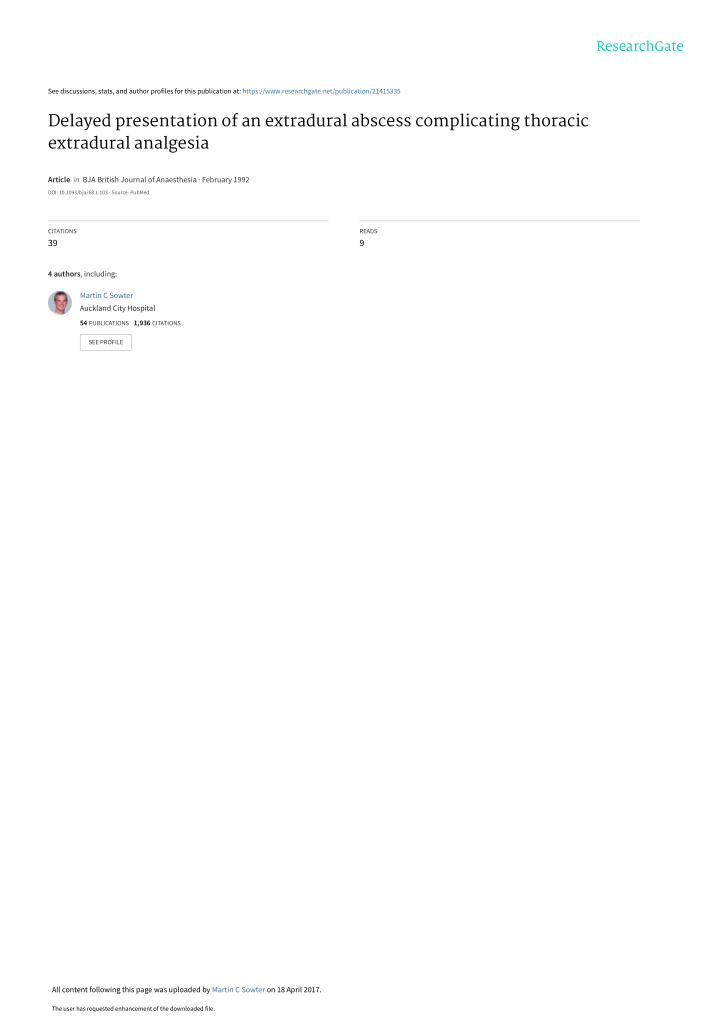



See discussions, stats, and author profiles for this publication at: https://www.researchgate.net/publication/21415335 Delayed presentation of an extradural abscess complicating thoracic extradural analgesia Article in BJA British Journal of Anaesthesia · February 1992 DOI: 10.1093/bja/68.1.103 · Source: PubMed CITATIONS READS 39 9 4 authors , including: Martin C Sowter Auckland City Hospital 54 PUBLICATIONS 1,936 CITATIONS SEE PROFILE All content following this page was uploaded by Martin C Sowter on 18 April 2017. The user has requested enhancement of the downloaded file.
British Journal of Anaesthesia 1992; 68: 103-105 CASE REPORTS DELAYED PRESENTATION OF AN EXTRADURAL ABSCESS COMPLICATING THORACIC EXTRADURAL ANALGESIA M. C. SOWTER, N. A. BURGESS, P. V. WOODSFORD AND M. H. LEWIS 4.7 x 10" litre" 1 . Coagulation screen and serum elec- SUMMARY trolyte concentrations were normal. Premedication comprised lorazepam 2 mg orally 2 h before induc- Extradural abscess is a rare but recognized com- tion and hydrocortisone 100 mg i.m. 1 h before plication of extradural anaesthesia. Previous reports induction. Anaesthesia was induced with propofol have been associated with a short time interval 160 mg, morphine 10 mg and atracurium 40 mg. between extradural catheterization and presen- Anaesthesia was maintained with infusion of pro- tation. We report a patient with rheumatoid arthritis, pofol 400 mg h" 1 , reducing to 300 mg h" 1 and atra- receiving steroid therapy, in whom an extradural curium 0.5 mg kg" 1 h" 1 . The trachea was intubated abscess did not present until 23 days after the and the lungs ventilated with oxygen and air. insertion of a thoracic extradural catheter to provide Intraoperative monitoring comprised direct arterial postoperative analgesia. pressure measurement, central venous pressure via the left antecubital vein, ECG, end-tidal carbon KEY WORDS dioxide, FI OJ and pulse oximetry. Anaesthetic techniques: extradural. Complications: extradural At induction he was given augmentin 1.2 g and abscess. metronidazole 500 mg i.v. as prophylaxis. An extra- dural catheter was inserted for intra- and post- operative analgesia. The procedure was performed CASE REPORT in the operating theatre with the patient in the left A 62-yr-old retired factory foreman was admitted lateral position. The skin was cleansed with a as an emergency after collapsing while shopping. solution of 2.5% chlorhexidine in 70% alcohol and After a few seconds of unconsciousness, he com- a strict aseptic technique was practised. plained of feeling faint with a constant, dull, non- A Portex 18-guage Mini-Epidural pack was used pleuritic retrosternal and left-sided chest pain. There and the extradural space was identified using "loss of was no associated dyspnoea or neurological deficit. resistance to air". An 18-gauge Tuohy needle was These symptoms resolved over 30 min. In his past inserted at the T9—T10 interspace and a clear nylon medical history it was notable that he had been catheter was inserted 5 cm into the extradural admitted to hospital with a myocardial infarction 2 space. A bacterial filter (0.2-um pore size) was years previously and that for 20 years he had suffered attached and the puncture site sprayed with an from rheumatoid arthritis. His medication included antibiotic (containing bacitracin, polymixin and aspirin 75 mg once a day; penicillamine 125 mg neomycin). The surrounding area was dressed with a three times daily; flurbiprofen 50 mg three times a plastic, moisture-permeable dressing, impenetrable day; atenolol 50 mg once a day; isosorbide dinitrate to bacteria. 20 mg three times a day; glyceryl trinitrate as An extradural infusion of 0.25% bupivacaine required. 25 ml, fentanyl (10 ml of a 0.05-mg ml" 1 solution) On admission, he was in sinus rhythm with a and normal saline 15 ml was commenced at 5 ml h" 1 rate of 50 beat min" 1 ; arterial pressure was during operation. The effective level of analgesia 90/50 mm Hg and there was a tender pulsatile produced by the extradural infusion during opera- midline abdominal mass. Examination was otherwise tion could not be determined because the patient normal. A syncopal episode related to beta-blockade was already anaesthetized before insertion of the was diagnosed, with a secondary finding of an extradural. However, during surgery there were no abdominal aortic aneurysm. Atenolol was dis- clinical indications that the combination of extra- continued and isosorbide dinitrate was reduced to dural infusion, i.v. morphine given at induction, and 10 mg three times a day. Ultrasound examination the continued infusion of propofol were not effective confirmed the presence of a 4.8-cm abdominal aortic in producing adequate analgesia. The intraoperative aneurysm which appeared to have dissected, but not course of the anaesthetic was uneventful. There were leaked. Two days after admission, he underwent repair of abdominal aortic aneurysm with an 18-mm straight, M. C. SOWTER, B.SC., M.B., CH.B.J N. A. BURGESS, F.R.C.S.; P. V. WOODSFORD, M.B., B.S., F.C.ANAES.; M. H. LEWIS, M.D., F.R.C.S.; non-porous Dacron graft. Before operation, full East Glamorgan Hospital, Church Village, Nr Pontypridd, Mid blood count showed a haemoglobin concentration of Glamorgan CF38 1AB. Accepted for Publication: August 5, 1991. 12.3 gdl" 1 and a white blood cell count of Correspondence to M. H. L.
Recommend
More recommend